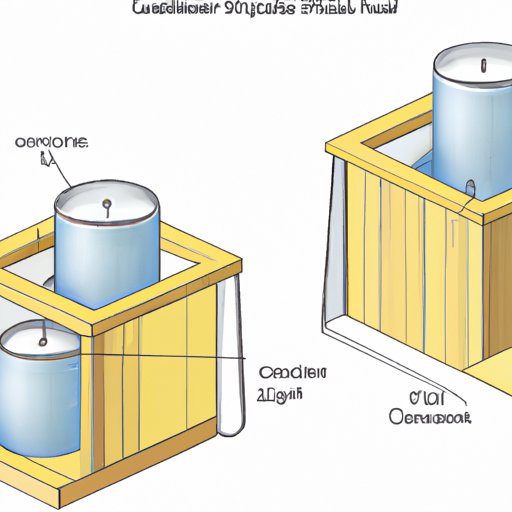
I. Introduction to Calculating the Volume of a Cylinder
A cylinder is a 3-dimensional geometric shape that has a circular base and a curved surface that extends upward in a straight line. The volume of a cylinder is the amount of space that it occupies. In this article, we will explore how to calculate the volume of a cylinder and its practical applications.
Calculating the volume of a cylinder is necessary in many fields, such as engineering, architecture, physics, and chemistry. Understanding the volume of a cylinder is important when designing and manufacturing cylindrical objects, such as pipes, containers, and structures.
II. Visual Guide to Calculate the Volume of a Cylinder
The volume of any 3-dimensional object is defined as the amount of space it occupies. For a cylinder, its volume is calculated by multiplying the area of the base circle by the height of the cylinder.
The formula for the volume of a cylinder:
V = πr2h
where V is the volume, π is the mathematical constant pi (3.14), r is the radius of the base, and h is the height of the cylinder.
To calculate the volume of a cylinder, follow these steps:
- Measure the diameter or radius of the base circle
- Measure the height of the cylinder
- Calculate the radius of the base circle by dividing the diameter by 2
- Calculate the area of the base circle by using the formula: A = πr2
- Multiply the area of the base circle by the height of the cylinder to get the volume: V = A x h
Visual aids, like diagrams and illustrations, can help make the process of calculating cylinder volume much easier to understand.
III. Applications of Cylinder Volume
The volume of a cylinder has numerous practical applications in many fields, including engineering and architecture. For instance, the volume of pipes used in plumbing must be accurately calculated. In architecture, understanding the volume of columns and support beams is critical to designing safe and sustainable structures. In product development, determining the volume of containers is necessary for accurate measurements of ingredients and materials.
IV. How to Use Calculus to Calculate Cylinder Volume
Calculus is a branch of mathematics that deals with rates of change and how things change over time. It can be used to analyze curves and to find the volume of irregular shapes, like a cylinder that is not perfectly symmetrical.
The formula for calculating the volume of a cylinder using calculus is:
V = ∫ A(x) dx
where A(x) represents the cross-sectional area of the cylinder at any given height, and ∫ represents the integral function.
To calculate the volume of a cylinder using calculus, follow these steps:
- Determine the function for the cross-sectional area of the cylinder at any height above the base.
- Integrate the area function over the height of the cylinder to obtain the volume.
V. Fun Visual Experiment on the Cylinder’s Volume
An engaging way to learn how to calculate cylinder volume is through a visual experiment. You can use everyday materials to demonstrate the process.
For example, fill a cylindrical container with water and measure the amount of water in milliliters. Measure the height and diameter of the cylinder, calculate the radius, and plug in the numbers into the formula (V = πr2 h) to find the volume. Compare the calculated volume to the amount of water that was initially in the cylinder to see if the calculation is accurate.
This experiment can help make the learning process more interactive and engaging for both adults and children.
VI. History and Development of Cylinder Volume
Archimedes, a mathematician and inventor in ancient Greece, was one of the first to calculate the volume of a cylinder. He famously discovered the principle of buoyancy while taking a bath and used his newfound knowledge to calculate the volume of a crown – a task given to him by a king who wanted to know whether the crown was made of pure gold.
The concept of volume calculation has been studied extensively and is used in various modern fields, such as engineering, physics, and architecture. Additionally, the concept of volume has played a significant role in the development of technology, from designing steam engines and hydraulic systems in the 19th century to design pipes and containers in modern times.
VII. Conclusion
Calculating the volume of a cylinder is essential in many fields, including engineering, architecture, and product development. In this article, we explored different ways of calculating cylinder volume, including using calculus and visual aids. We also explored the historical and scientific significance of this concept and how it has been applied throughout history. By following the step-by-step process, anyone can learn how to calculate the volume of a cylinder quickly, accurately, and easily.





